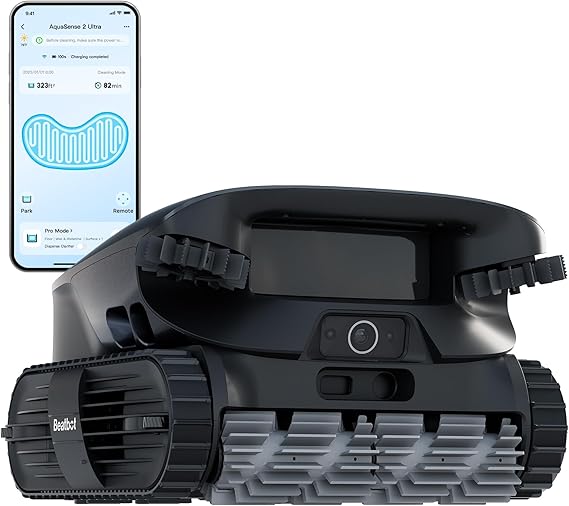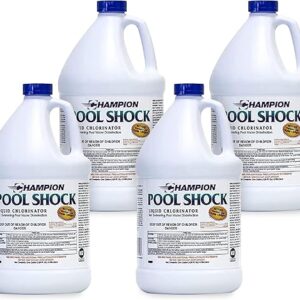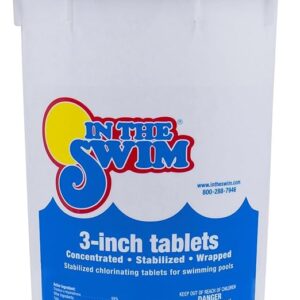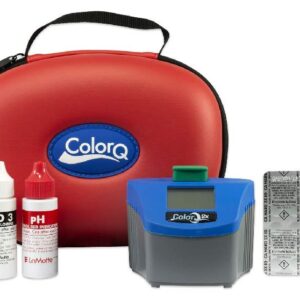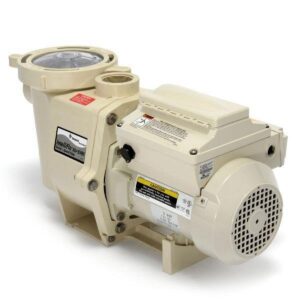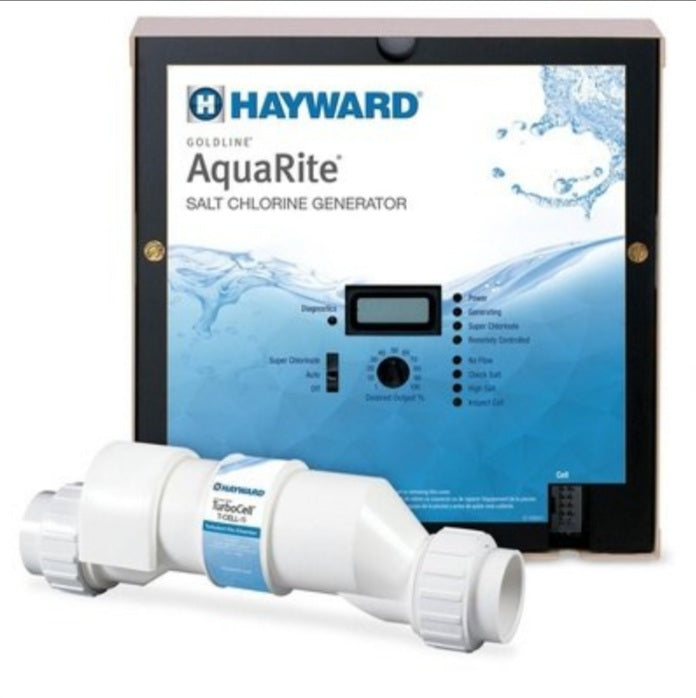The Ultimate Guide to Swimming Pool Maintenance
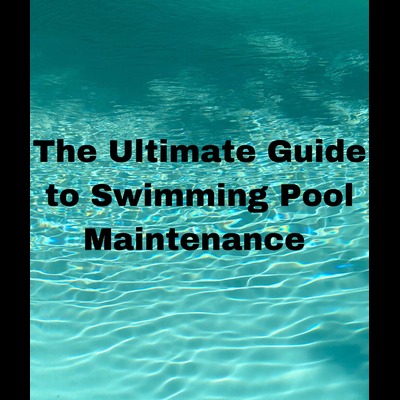
Introduction
Whether you’re a new pool owner or a seasoned pro, swimming pool maintenance is crucial for its longevity, water quality, and, most importantly, enjoyment.
In this comprehensive guide, we will take you through the ins and outs of pool maintenance, covering everything, including:
- Understanding your swimming pool
- Essential pool maintenance equipment
- Essential pool maintenance chemicals
- Daily and Weekly pool maintenance routine
- Preventive measure
- Troubleshooting common swimming pool problems
- Safety and pool regulations
- Tips for an energy-efficient swimming pool
- Pool closing and winter maintenance
- Pool upgrade and renovations and
- When to hire an expert
Before we go further, let me introduce a saltwater pool maintenance guide for those using Saltwater Chlorine Generators (SWCGs).
On the other hand, if you have a Spa or Hot Tub, here is a detailed hot tub and Spa maintenance guide.
Most Loved Cordless Pool Cleaner: Aiper Scuba S1 Cordless Robotic Pool Vacuum Cleaner: Cleaning Schedule, Smart Navigation, Wall, Floor, & Waterline Cleaning, Suitable for all Pools Up to 1,600 sq.ft
Chapter 1. Understanding Your Swimming Pool
Swimming pools come in various shapes and sizes, each with unique features and maintenance requirements. To start your journey toward becoming a pool maintenance expert, let’s understand the basics.
1. Types of Swimming Pools:
- Inground Pools: These are fixed pools and the most common and can be made of concrete, vinyl, or fiberglass materials in the ground.
- Above-Ground Pools: Above-ground pools make it easy to own a swimming pool. They are typically more affordable, portable, and easier to install than inground pools. They come in various shapes and sizes.
2. Components of a Swimming Pool:
To effectively maintain your pool, you need to know its key components: Here are the main components of a swimming pool.
Pump and Filter: These work together to circulate and clean your pool water, removing debris and contaminants before water enters the pool through the return jet. The pool pump creates suction, drawing water (and floating debris) into the skimmer.
The skimmer is a vital part of the filtration system. It collects leaves, bugs, and other debris on the pool’s surface preventing large debris from entering the pump and main filter. Water flows from the skimmer basket into the pool pump and filtration system, where fine particles and contaminants are filtered out.
3. Pool Water Circulation and Filtration
Understanding how water circulates through your pool is fundamental to maintaining crystal-clear water.
Your pool’s water is continuously circulated through the pump, filter, and return jets. The pump pulls water from the pool through the skimmer where large debris is filtered, passes it through the filter to remove impurities, and then returns clean water to the pool via the jets. This process ensures that the water remains clean and safe for swimming.
Chapter 2: Essential Swimming Pool Maintenance Equipment and Chemicals
Before diving into regular pool maintenance, gathering the right tools and equipment is essential. Here are some of the must-haves:
Pool Vacuum Cleaners: Vacuum cleaners make pool and spa maintenance easier and less time-consuming. They come in various types, including manual and automatic, and help you clean the pool floor and walls by removing fine and large debris. You may not need to use hand skimmers and pool brushes if you have a robotic pool cleaner.
Hand Skimmers and Nets: These tools remove leaves, insects, and debris from the pool’s surface.
Pool Brushes: Brushes remove algae and dirt from the pool walls and floor.
Water Testing Kits: These kits measure crucial water parameters like pH, chlorine, alkalinity, etc.
Pool Chemicals: Liquid chlorine, tablet chlorine, or granular chlorine, pH increaser, pH decreaser, alkalinity increaser, calcium hardness increaser, algaecides, and stabilizers are some chemicals you need to maintain water quality.
Pool Heaters: If you want to enjoy swimming year-round, a pool heater is essential for maintaining a comfortable water temperature.
Chlorine Generator: These devices help to add chlorine automatically into your pool. A chlorine generator produces chlorine, which is crucial for sanitizing your pool.
Pool Covers: Investing in a good pool cover helps protect your pool from debris and reduces water evaporation.
The following chapters delve into a weekly maintenance routine, preventative measures, and troubleshooting common pool problems. Stay with us on this journey to ensure your swimming pool remains a pristine and inviting oasis.
Chapter 3: Daily and Weekly Swimming Pool Maintenance Routine
1. Testing and Adjusting Water Chemistry
Maintaining proper water chemistry is vital for swimmers’ comfort and safety. Use your water testing kit to measure critical parameters daily and adjust chemicals as appropriate: Here are the recommended chemical levels for a swimming pool.
- pH: Aim for a pH level between 7.4 and 7.6.
- Chlorine: Maintain a free chlorine level of 3 ppm.
- Total Alkalinity: Keep total alkalinity between 80-120 ppm.
- Calcium Hardness: Aim for a calcium hardness level of 200-400 ppm.
- Stabilizer (Cya): Maintain Cyanuric acid level between 30-50ppm
Adjust chemical levels as needed to ensure your pool water is balanced and safe for swimming.
Related Products: View All the Necessary Swimming Pool Chemicals
2. Skimming and Cleaning Debris
One of the easiest and most frequent pool maintenance tasks is skimming. It is necessary to prolong the lifespan of your pump and filter. Use your skimmers and nets to remove leaves, insects, and other debris accumulating on the pool’s surface. This should be done at least once daily, if not more often, during peak shedding seasons.
3. Brushing the Pool Walls and Floor
Regular brushing prevents algae buildup and maintains a sparkling pool interior. Use a pool brush to scrub the walls and floor, paying extra attention to corners and crevices where algae can thrive. Aim to brush your pool every few days to a week.
4. Emptying Skimmer and Pump Baskets
The skimmer and pump baskets collect larger debris that the hand skimmers miss. Regularly check and empty these baskets to ensure proper water flow and circulation. Neglecting this step can strain your pump and filter, leading to more significant maintenance issues.
5. Checking and Cleaning Filters
Pool filters are critical in removing small particles and impurities from your water. The three most common types of pool filters are sand, cartridge, and diatomaceous earth (DE). Each requires specific maintenance:
- Sand Filters: Periodically backwash the filter to remove trapped debris. The sand filter should be backwashed every 4 weeks or when the pressure gauge reads 8-10 pounds per square inch (PSI) above normal starting pressure.
- Cartridge Filters: Clean cartridge filters every 3-6 months or when the pressure gauge reads 8-10 PSI above normal starting pressure. Replace cartridges should be after 1-2 years, or when the cartridges wear out or are damaged.
- DE Filters: Clean the DE filter when the pressure gauge reads 8-10 psi above its normal starting pressure. Generally, the DE filter is cleaned every month. Always add fresh DE powder or agent after cleaning to re-coat the filter grids.
6. Vacuuming the Pool
Regularly use a manual or automatic pool vacuum to free your pool floor and walls from debris and algae. Manual pool vacuums require more effort and time but offer precise control, while automatic ones can operate independently with minimal supervision.
Related Product: Beatbot AquaSense Cordless Robotic Pool Vacuum Cleaner for Above Ground and Inground Pools Up to 2260 sq. ft
7. Running the Pool Pump and Filter
Maintain water circulation and filtration by running your pool pump and filter for the recommended duration each day. Consult your pool equipment’s manual for guidance on optimal run times.
Chapter 4: Preventative Maintenance
Preventative maintenance is about taking proactive steps to ensure your pool operates smoothly and to avoid potential issues. Here’s what you need to know:
1. Regular Inspections
Perform routine visual inspections of your pool and its equipment. Look for signs of wear, damage, leaks, rust, or corrosion. Check for loose fittings or connections. By catching issues early, you can prevent more significant problems.
2. Winterizing Your Pool
If you live in an area with cold winters, it’s essential to winterize your pool. Winterizing a swimming pool involves several steps, such as draining water below the skimmer level, removing equipment, adding winterizing chemicals, and placing a winter cover. Proper winterization protects your pool from freezing and damage.
3. Opening Your Pool for the Summer
Just as winterizing is essential, so is appropriately opening your pool in time for the summer season to prevent algae growth. This includes cleaning and reassembling equipment, adjusting chemical levels, and ensuring everything is in working order.
4. Seasonal Maintenance Tasks
Each season may require specific maintenance tasks. For example, the summer months may demand more frequent chemical adjustments due to increased pool usage, while fall may require more attention to leaf removal.
5. Dealing with Algae Growth
Algae can persist in pools, especially during hot and sunny weather. Use algaecides and shock treatment to address and prevent algae growth. Regular brushing and maintaining proper chlorine levels also help keep algae at bay.
6. Handling Pool Stains and Scaling
Stains and scaling can occur due to various factors, including imbalanced water chemistry. Use metal stain and scale removers to remove stains and for prevention purposes. Addressing the root cause, such as adjusting pH and alkalinity levels, is critical to preventing future stains.
7. Pool Leak Detection and Repair
If you suspect a pool leak, it’s crucial to identify and repair it promptly. Even a tiny leak can lead to water and energy waste. Look for drops in water level, soggy ground around the pool, or increased water bills.
The following chapters will explore troubleshooting common pool problems, safety measures, energy-efficient options, and more. Proper preventative maintenance is your best defense against unexpected pool issues and costly repairs.
Chapter 5: Troubleshooting Common Pool Problems
Even with regular maintenance, pool issues can occasionally arise. Identifying and addressing these problems promptly can save you time, money, and frustration. Let’s look at some common pool problems and how to troubleshoot them:
1. Cloudy Water
Cloudy water can result from various factors, including imbalanced water chemistry or inadequate filtration. To clear cloudy water: Here are the tasks to perform depending on the course of cloudy water:
- Test and balance your water chemistry, ensuring proper pH and free chlorine levels. Low free chlorine levels cause cloudy water.
- Run the pool pump and filter for an extended period to improve circulation.
- Consider using a pool clarifier to help clear fine particles.
- Backwash or clean your filter as needed to maintain optimal filtration.
Related Article: 7 causes of cloudy swimming pool water and remedies
2. Algae Bloom
Green algae are the most common and the easiest to deal with. It can quickly take over a pool if not addressed promptly. Other types of algae are yellow and black, which are considered the toughest to get rid of. To treat and prevent algae growth:
- Brush the affected areas to loosen the algae. Yellow and black algae may need a stainless steel pool brush to clear.
- Shock the pool with liquid chlorine to kill the algae.
- Use an algaecide to prevent regrowth.
- Maintain proper chlorine levels and regular brushing to keep algae at bay.
Related Article: Types of algae and how to clear algae
3. Low or High pH Levels
Imbalanced pH levels can lead to various water issues, from skin and eye irritation to equipment damage. To adjust pH levels:
- Add muriatic acid or sodium bisulfate to lower the pH if high
- Add soda ash or sodium carbonate to raise the pH if low.
Monitor and adjust pH regularly to maintain balance. This will save you from more difficult and costly pool problems like balancing pH and TA.
Related Article: How to Balance pH and Total alkalinity
4. Insufficient Water Circulation
Insufficient water circulation can result in uneven chemical distribution and poor filtration. To address circulation issues:
- Check for clogged skimmers, pump baskets, or impellers and clean as necessary.
- Ensure your pool pump is functioning correctly and is sized appropriately for your pool.
- Adjust the pump’s run time to improve circulation.
- Consider adding return jets or using a variable-speed pump for better water movement.
5. Pump and Filter Issues
If your pool pump or filter experiences problems such as unusual noises or reduced flow, inspect and address the issue promptly:
- Check for clogs or obstructions in the pump or filter.
- Replace worn or damaged parts, such as o-rings or seals.
- Lubricate moving parts as recommended by the manufacturer.
- Schedule regular maintenance, such as filter cleaning or sand replacement.
6. Pool Heater Problems
Pool heaters can develop issues over time, affecting your ability to maintain a comfortable water temperature:
- Inspect the heater for visible damage or corrosion.
- Clean or replace the heater’s burners and heat exchangers.
- Check and clean the pilot light or ignition system.
- Consult a professional for more complex heater repairs or replacements.
Related Product: Raypak 399,000 BTU Natural Gas Pool Heater – Electric Ignition
7. Pool Plumbing Leaks
Detecting and repairing plumbing leaks is crucial to prevent water loss and damage:
- Look for signs of water loss, including soggy ground, decreased water level, or increased water bills.
- Conduct a pressure test to identify the location of the leak.
- Repair or replace the damaged plumbing components.
- Monitor for any new leaks or water loss.
Addressing these common pool problems promptly will help you maintain a clean, safe, and enjoyable swimming environment for yourself and your guests.
Related Article: Type of Pool Leaks, Detection, Prevention and Signs Your Pool is Leaking
Chapter 6: Safety and Pool Regulations
Ensuring the safety of swimmers and complying with pool regulations is paramount. This chapter will explore essential safety guidelines and the importance of adhering to local pool regulations and permits.
1. Pool Safety Guidelines
Safety should always be a top priority when it comes to pool ownership. Here are some crucial safety guidelines to follow:
- Pool Fence Locks: Install a proper pool safety fence with a self-latching gate to restrict access to the pool area. Ensure your pool fence has childproof locks out of a child’s reach.
- Supervision: Never leave children or inexperienced swimmers unsupervised near the pool.
- Safety Equipment: Keep lifebuoys, life jackets, and safety ropes within easy reach of the pool.
- Learn CPR: CPR can be a lifesaver in emergencies.
- Pool Rules: Establish and enforce pool rules, such as no running, diving in designated areas, and no glass containers near the pool.
- Pool Covers: Invest in safety pool covers that can support a child’s weight.
- Alarms: Install pool alarms that alert you to unauthorized pool access.
3. Local Pool Regulations and Permits
Different regions may have specific regulations and permit requirements for swimming pools. It’s crucial to:
- Research Local Regulations: Understand the local laws and regulations governing pool ownership in your area.
- Obtain Necessary Permits: Obtain the necessary permits before building or installing a pool.
- Regular Inspections: Comply with inspection requirements to ensure your pool meets safety standards.
By following these safety guidelines and adhering to local regulations, you can enjoy your pool with peace of mind, knowing you’ve taken steps to keep it safe for everyone.
In the next chapter, we’ll explore tips for making your pool more energy-efficient, saving you money while reducing your environmental impact.
Chapter 7: Tips for Pool Energy Efficiency
Maintaining an energy-efficient swimming pool helps reduce energy operational costs and minimizes your environmental footprint. In this chapter, we’ll explore various strategies to make your pool more energy-efficient:
Variable-Speed Pool Pumps: These pumps can adjust their speed to match your pool’s specific needs, saving energy compared to traditional single-speed pumps.
Energy-Efficient Pool Heaters: If you use a pool heater, opt for a model that uses energy-efficient technology, a gas pool heater, or a solar pool heater if you live in sunny areas.
LED Pool Lighting: Replace traditional pool lighting with energy-efficient LED fixtures, which consume less electricity and last longer.
Solar Pool Covers: Solar covers reduce water evaporation and capture and use solar energy to heat your pool. They are a cost-effective way to maintain a comfortable water temperature.
Chapter 8: Pool Closing and Winter Maintenance
As the swimming season ends, it’s essential to properly close your pool to protect it during the winter months. Here’s a step-by-step guide to pool closing and winter maintenance:
Winterizing Your Pool
1) Balance Chemicals: Adjust your pool’s pH and alkalinity levels to balance the water properly.
2) Clean the Pool: Remove debris, vacuum the pool, and brush the walls and floor.
3) Lower Water Level: Lower the water level below the skimmer and return jet levels to prevent freezing damage.
4) Winterize Plumbing: Remove and store all pool equipment, including the pump, filter, and heater. Blow out the plumbing lines to remove water and prevent freezing.
5) Add Winter Chemicals: Add winterizing chemicals, such as algaecide and a winterizing kit, to protect your pool during the off-season.
6) Install a Winter Cover: Cover your pool with a winter pool cover designed to keep debris out and support the weight of snow and ice.
Protecting Your Pool from Freezing
During the winter, it’s essential to monitor your pool to prevent damage from freezing temperatures:
1) Regular Inspections: Periodically check the pool cover and water level. Remove any accumulated snow or ice to prevent excessive weight on the cover.
2) Monitor Water Level: If water levels drop due to evaporation, add water to maintain the recommended level.
3) Snow Removal: Safely remove heavy snow loads from the pool cover to prevent damage.
4) Check Equipment: Inspect stored equipment for damage or corrosion and make any necessary repairs or replacements.
Off-Season Maintenance
While your pool may not be in use during the winter, it’s essential to perform off-season maintenance to ensure a smooth opening in the spring:
1) Inspect Pool Structure: Check for any signs of damage or wear on the pool structure, including the liner or surface.
2) Equipment Maintenance: Clean, lubricate, and store pool equipment properly.
3) Plan for Opening: Make a checklist for the tasks you’ll need to perform when opening the pool in the spring, such as adjusting chemicals and reassembling equipment.
Following these steps for pool closing and winter maintenance will protect your pool from freezing damage. These ensure a trouble-free opening when the warm weather returns.
In the next chapter, we’ll explore options for upgrading and renovating your pool to enhance its functionality and aesthetics.
Chapter 9: Pool Upgrades and Renovations
Pool upgrades and renovations can breathe new life into your swimming pool, enhancing its functionality and aesthetics. Whether you’re looking to add exciting features, improve efficiency, or refresh the pool’s appearance, this chapter will guide you through the options available:
Adding Pool Features
1) Water Features: Waterfalls, fountains, and bubblers can create a visually stunning and soothing atmosphere in your pool area.
2) Slides and Diving Boards: If you have the space, consider adding a slide or diving board for added fun and entertainment.
3) Lighting: LED lighting can transform your pool at night, creating an elegant and inviting ambiance.
4) Outdoor Kitchens and Bars: Enhance your poolside experience by adding an outdoor kitchen or bar area for convenient dining and entertainment.
5) Pool Decks and Patios: Upgrade your pool’s surroundings with beautiful decking and patio options, such as stamped concrete, pavers, or natural stone.
Pool Resurfacing Options
Over time, the surface of your pool may become worn or stained. Consider these resurfacing options to rejuvenate its appearance:
1) Plaster: Traditional pool plaster provides a smooth finish and can be customized with various colors.
2) Aggregate Finishes: Pebble or aggregate finishes offer a textured and natural appearance, providing durability and aesthetics.
3) Tile: Tile is a classic choice for pool surfaces, offering a wide range of design options and excellent durability.
4) Fiberglass: If you have a fiberglass pool, refinish it with a new gel coat to restore its shine.
5) Vinyl Liner Replacement: If you have an above-ground or vinyl-lined pool, replacing the liner can instantly refresh the pool’s appearance.
Chapter 10: When to Hiring Professional Help
While homeowners can manage many aspects of pool maintenance, there are times when it’s necessary to consult with or hire pool professionals. In this chapter, we’ll explore when and how to seek professional assistance:
When to Consult a Pool Professional
1) Complex Repairs: If your pool experiences major equipment failures or structural issues, it’s wise to consult a pool repair and renovation professional.
2) Water Chemistry Challenges: A pool service professional can diagnose and address the issue if you need help maintaining proper water chemistry.
3) Renovation Projects: For large-scale renovations, such as resurfacing, adding features, or extensive landscaping, hiring a pool contractor is advisable.
4) Seasonal Openings and Closings: If you need clarification on the proper procedures for opening and closing your pool, consider hiring a professional service to ensure it’s done correctly.
Finding and Hiring Pool Service Providers
1) Research: Seek recommendations from friends, family, or online reviews to find reputable pool service providers in your area.
2) Interview Prospective Providers: Contact several pool professionals to discuss your needs and obtain quotes. Ask about their experience, certifications, and references.
3) Check Credentials: Verify that the pool service provider is licensed, insured, and bonded to protect yourself and your investment.
4) Agree on Services: Clearly define the scope of services, schedule, and pricing with the provider before entering into a contract.
5) Communication: Maintain open contact with your pool service provider to ensure they understand your expectations and can address any concerns promptly.
Working with pool professionals can ensure that your pool receives the expert care it needs, especially for complex projects and when you lack the time or expertise to handle certain aspects of pool maintenance.
Conclusion
Congratulations! You’ve completed “The Ultimate Guide to Swimming Pool Maintenance.” Following the guidelines and tips in this guide, you can confidently maintain your swimming pool, keep it in top condition, and enjoy a safe and refreshing oasis in your backyard.
Remember that pool maintenance is an ongoing process, and regular care will contribute to the longevity and enjoyment of your pool for years to come.


